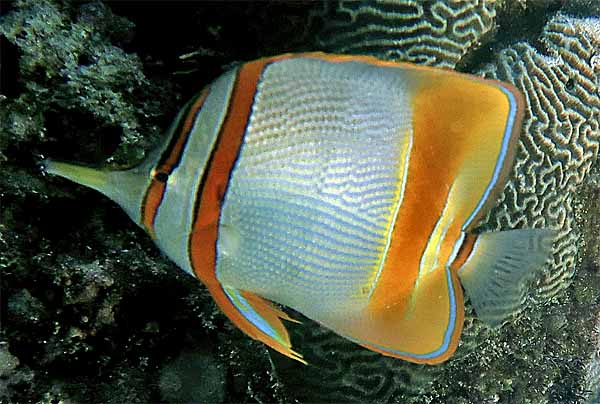Chelmon marginalis
Richardson, 1842
|
Familie: Chaetodontidae SynonymeChelmon rostratus marginalis Richardson, 1842 Lokale Bezeichnung |
Typen
Holotypus: BMNH 1843.6.15.48 (Haut) .
Siehe: Eschmeyer, W.N., Fricke, R. & Van der Laan, R. (eds.) 2024. Catalog of Fishes electronic version
Typusfundort: Port Essington, Nordterritorium, Australien.
Etymologie
Marginalis (= gesäumt oder umrandet), bezieht sich auf die submarginalen dunklen Bänder (im Leben orange und blau) um die weichen Teile der Rücken- und Afterflossen (die bei dem ähnlichen Chelmon rostratus fehlen).
Verbreitung
Indo-Westpazifik.
IUCN Status

EX Extinct (ausgestorben)
EW Extinct in the Wild (in der Natur ausgestorben)
CR Critically Endangered (vom Aussterben bedroht)EN Endangered (stark gefährdet)
VU Vulnerable (gefährdet)
NT Near Threatened (potenziell gefährdet)
LC Least Concern (nicht gefährdet)
RE Regionally Extinct (regional oder national ausgestorben)DD Data Deficient (ungenügende Datengrundlage)
NE Not Evaluated (nicht beurteilt)
LC Least Concern (nicht gefährdet)
Gefahren für diese Art: Es scheint keine größeren Bedrohungen für diese Art zu geben. Sie wird nur in begrenztem Umfang gesammelt, und es wird nicht davon ausgegangen, dass dies die Gesamtpopulation beeinträchtigt.
Literatur
- Richardson, J. 1842. Contributions to the ichthyology of Australia. Annals and Magazine of Natural History, (New Series) 10 (62): 25-34. (BHL) Zitatseite [:29, !!]
- Richardson, J. 1846. Descriptions of six fish. Pp. 484-497, Pls. 1-4. In: J. L. Stokes, 1846: Discoveries in Australia with an account of the coasts and rivers explored and surveyed during the voyage of H. M. S. Beagle, in the years 1837-38-39-40-41-41-42-43. By command of the Lords Commissioners of the Admirality. Also a narrative ... islands in the Arafura Sea. vol. 1, Appendix. London. T. and W. Boone, London. xii + 521 pp., Pls. (PDF) Zitatseite [:491, Pl. 4, Beschreibung]
- Castelnau, F.L. 1875. Researches on the fishes of Australia. 1-52. (PDF) Zitatseite [:14, !!, als Chelmo tricinctus]
- Burgess, W.E. 1978. Butterflyfishes of the World. A monograph of the family Chaetodontidae. T.F.H. Publ., Inc. Ltd., Neptune City, New Jersey, U.S.A. 1-832. Zitatseite [:126; Chelmo tricinctus als Synonym]
- Blum, S.D. 1989. Biogeography of the Chaetodontidae: an analysis of allopatry among closely related species. Environmental Biology of Fishes, 25 (1-3): 9-31. (doi) Zitatseite [:12]
